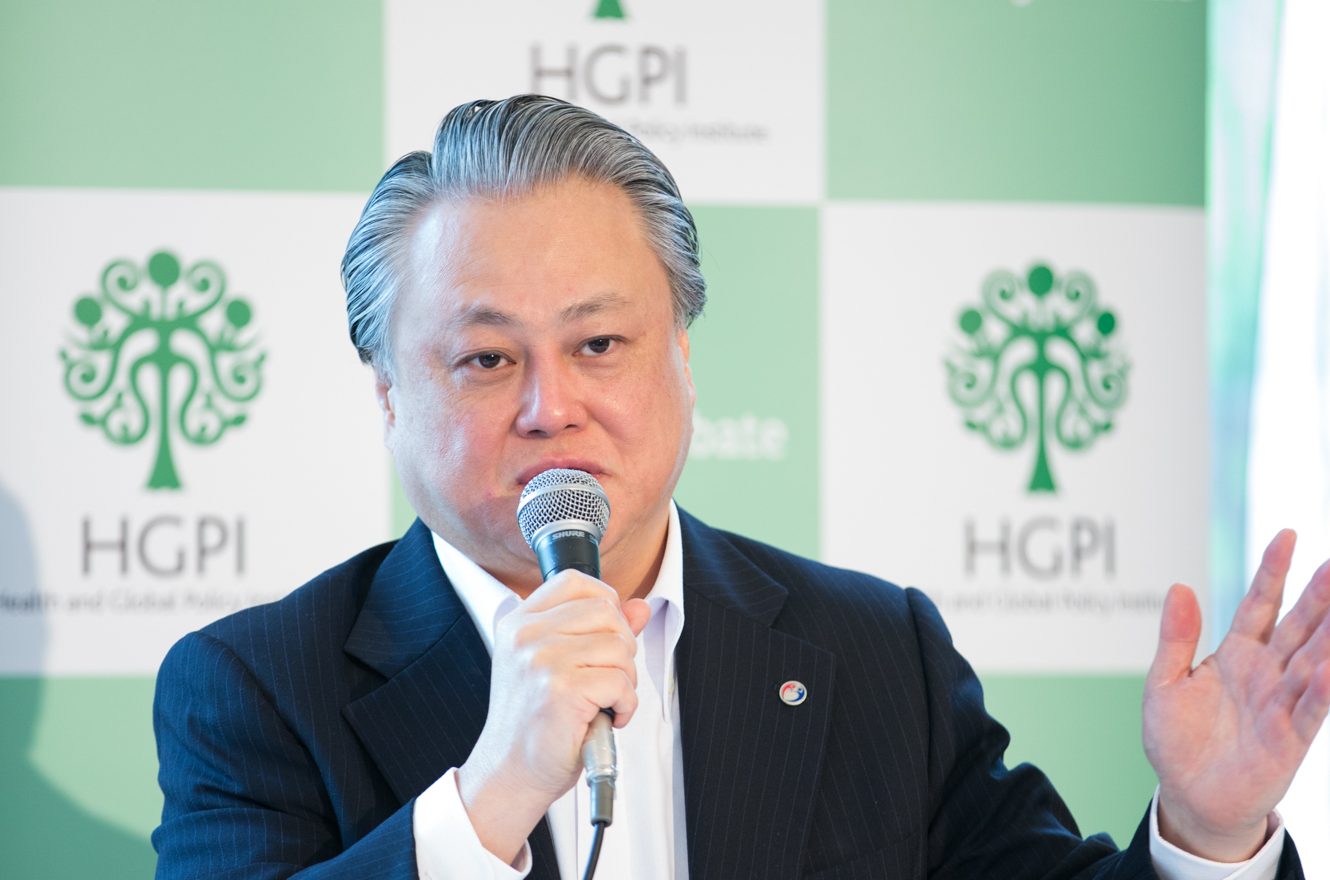[Event Report] The 40th Special Breakfast Meeting “The Social Security Challenges and the Focus for Healthcare towards 2040” Mr. Toshihiko Suzuki (May 21, 2018)
date : 7/4/2018
Tags: Future of the Health Care System, Innovation and Sustainability, Special Breakfast Meeting
![[Event Report] The 40th Special Breakfast Meeting “The Social Security Challenges and the Focus for Healthcare towards 2040” Mr. Toshihiko Suzuki (May 21, 2018)](https://hgpi.org/en/wp-content/uploads/sites/2/a98b1120712ae2558c294773114e59b3-2.jpg)
HGPI invited Mr. Toshihiko Suzuki from the Health Insurance Bureau of the Ministry of Health, Labour and Welfare (MHLW) to its special breakfast meeting.
■ Lecture summary
1 . Reforming the social-security system for the year 2040
There are plans to raise the consumption tax in October of 2019. If this raise is realized according to plan, it will be a milestone towards achieving the reform of the social security system by the year 2025. From now on, it will be important to envision how the social security system should be beyond the year 2025 through to the year 2040.
The biggest change that will occur by the year 2040 will be in the population’s demographic profile. From 2025 through 2040, the rate of increase in the number of elderly people will ease. The rise in the number of elderly people has up until now been considered to be a factor in the increase of medical and nursing expenses. After 2040 however, that population factor will become less prominent in determining medical care expenditures, and gradually, it will also become less important with regard to nursing care expenditures as well. Nevertheless, the accelerated decrease in the productive-age population will cause a shortage in medical and nursing care service staff. Moving forward, the Government should invest all of its energy into resolving this challenge.
Considering from a mid- to long-term perspective how the social security system should evolve, it is clear that, in addition to the revision of benefits and costs, Japan will face additional challenges as it attempts to ensure the sustainability of that system. One is how to extend the “healthy lifespan” of the population to enable the elderly to lead active lives. Another is how to improve productivity in order to maintain the same level of medical and nursing care in a dwindling workforce.
Extending “healthy lifespans”
By eliminating health disparities, the Government aims by 2040 to extend the healthy lifespan of the population by over 3 years. The Government wants to bridge the difference between average and healthy lifespans. To do so, the Government will prioritize two approaches – the “Promotion of health and prevention of disease among all, including the health-unconscious” approach and the “Elimination of regional disparities” approach.
There are three merits to increasing the healthy lifespan:
- An increase in the number of people who can enjoy physical and mental health throughout their lives will ease the burden on municipal healthcare insurance finances.
- The lucrative employment of the elderly will help reduce medical and nursing expenditures.
- The rise in the number of employed people will bring about an increase in tax revenue, which in turn will eventually foster economic growth.
Preventive medicine and health maintenance issues
- Measures to encourage disease prevention and prevent the aggravation of symptoms.
- Measures to cope with the deterioration of capabilities that occurs with aging (measures to prevent morbidity).
- Comprehensive legislation to deal with lifestyle diseases, morbidity, and preventive care.
Improving work productivity
In order to maintain the quality of medical and nursing services amidst rising demand and the rapid decrease in the productive-age workforce, it is necessary to increase productivity in the healthcare sector so as to ensure that the same level of services can be supplied. The application of the three concepts of “Task shifting,” “Use of technology,” and “Management reform” are vital to success in this.
With regard to technology in particular, great developments are expected in the future. Thanks to improvements in technology, the separation of work tasks between those jobs that can be totally entrusted to machines and jobs for which the presence of human operators is necessary may become possible. This would in turn bring about improvements in healthcare quality in spite of the limited workforce.
2. Social security benefits and expenditures
In spite of the sharp increase in the elderly population, Japan’s social security expenditure relative to its GDP is fairly constrained compared to other countries. When developing a system of social security which can cover all generations in society, it is important to avoid competition for resources between generations. In order to avert this, in addition to ensuring lifelong security for elderly people, wouldn’t it be beneficial for younger generations if a certain share of social security revenue was appropriated for support for childcare and children?
In every country, social security revenue is a combination of public and private payments. What differs between countries is the balance of public to private payments that make up the sum total for social security revenue.
Given Japan’s proclivity toward ensuring fairness in social services, isn’t it the will of the public that government revenue should be used to ensure that everyone can enjoy an equal level of social security services?
Looking at trends in the breakdown of public expenditures by revenue source, it is clear that payments into social security are rising, while tax revenue is not. It is very important that, after the consumption tax is raised to 10%, a platform be established very early on for discussions on how the tax system should best change in the future.
Discussion
The talk was followed by a lively Q&A session during which the concrete details of the broad policies covered by Mr. Suzuki’s presentation were discussed. There was also a conversation on the ideal overall direction for the healthcare sector in Japan in the future.
■ Mr. Toshihiko Suzuki
Director General of Health Insurance Bureau, Ministry of Health, Labour and Welfare (MHLW)
Mr. Toshihiko Suzuki started his career at the Ministry of Health and Welfare in April 1983. He served in several departments, including as head of the Division of Geriatric Care at the Health Insurance Bureau; as Cabinet Office Coordinator for Parliamentary Affairs; as Counsellor for the Minister’s Secretariat at MHLW; and as Director of the Financial Affairs Division for the Minister’s Secretariat at MHLW. Mr. Suzuki also served as Assistant Minister for Equal Employment, Children and Families, and for the Promotion of Measures to Cope with the Declining Birthrate at MHLW. Prior to his current position, Mr. Suzuki served as the Director General for the Social Welfare and War Victims’ Relief Bureau and the Pension Bureau respectively.


Top Research & Recommendations Posts
- [Research Report] Perceptions, Knowledge, Actions and Perspectives of Healthcare Organizations in Japan in Relation to Climate Change and Health: A Cross-Sectional Study (November 13, 2025)
- [Research Report] The 2025 Public Opinion Survey on Healthcare in Japan (March 17, 2025)
- [Policy Recommendations] Developing a National Health and Climate Strategy for Japan (June 26, 2024)
- [Policy Recommendations] Mental Health Project: Recommendations on Three Issues in the Area of Mental Health (July 4, 2025)
- [Announcement] HGPI Endorses the “Belém Health Action Plan” (November 14, 2025)
- [Research Report] The 2023 Public Opinion Survey on Satisfaction in Healthcare in Japan and Healthcare Applications of Generative AI (January 11, 2024)
- [Publication Report] Planetary Health Promotion Project “Issues Facing Planetary Health and the Role of the Health Sector” (May 10, 2023)
- [Announcement] HGPI Joins Global Green and Healthy Hospitals (August 1, 2023)
- [Research Report] Survey of Japanese Physicians Regarding Climate Change and Health (December 3, 2023)
- [Public Comment Submission] “Interim Evaluation of the Implementation Status of the National Biodiversity Strategy 2023-2030 (Draft)” and the “7th National Report under the Convention on Biological Diversity (Draft)” (December 2, 2025)
Featured Posts
-
2025-12-11
[Event Report] Core Components of Universal Health Coverage (UHC): Achieving “Healthcare Without Financial Hardship” in Asia-Pacific and Japan (December 5, 2025)
![[Event Report] Core Components of Universal Health Coverage (UHC): Achieving “Healthcare Without Financial Hardship” in Asia-Pacific and Japan (December 5, 2025)](https://hgpi.org/en/wp-content/uploads/sites/2/HGPI_20251210_Core-Components-of-Universal-Health-CoverageUHC-top.jpg)
-
2025-12-12
[Registration Open] Meaningful Involvement Promotion Project Urgent Symposium “The New Takaichi Administration and Central Social Insurance Medical Council Reform – Ensuring Patients’ Voices are Heard” (January 22, 2026)
![[Registration Open] Meaningful Involvement Promotion Project Urgent Symposium “The New Takaichi Administration and Central Social Insurance Medical Council Reform – Ensuring Patients’ Voices are Heard” (January 22, 2026)](https://hgpi.org/en/wp-content/uploads/sites/2/HGPI_20251208_urgent-symposium-1.png)
-
2025-12-12
[Registration Open] (Webinar) The 140th HGPI Seminar “Early Detection to Reduce COPD Disease Burden: Connecting Clinical Frontiers with Health Policy” (January 27, 2026)
![[Registration Open] (Webinar) The 140th HGPI Seminar “Early Detection to Reduce COPD Disease Burden: Connecting Clinical Frontiers with Health Policy” (January 27, 2026)](https://hgpi.org/en/wp-content/uploads/sites/2/hs140-top.png)




